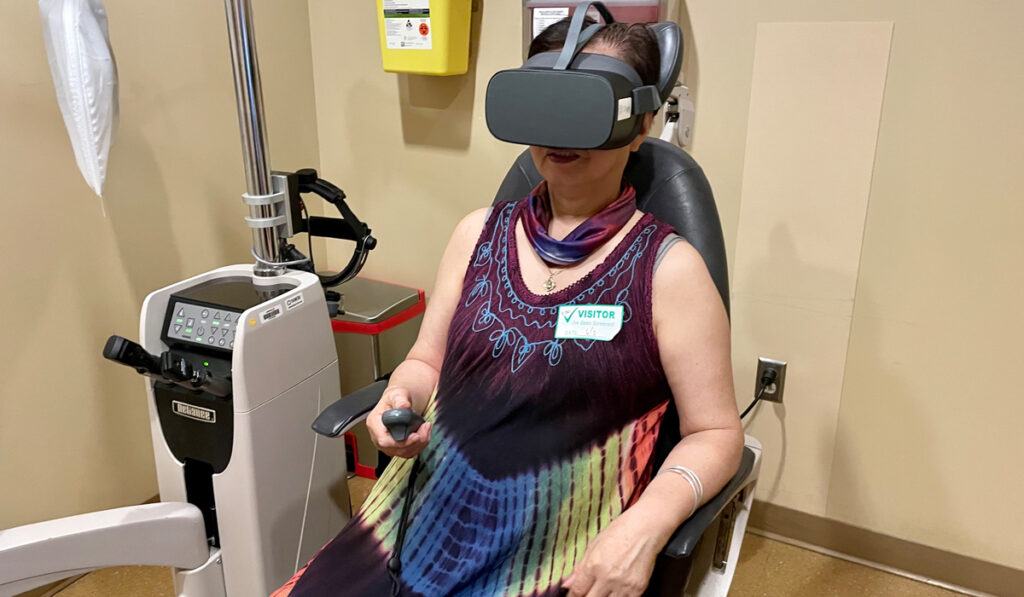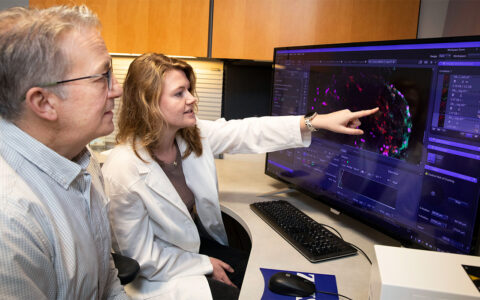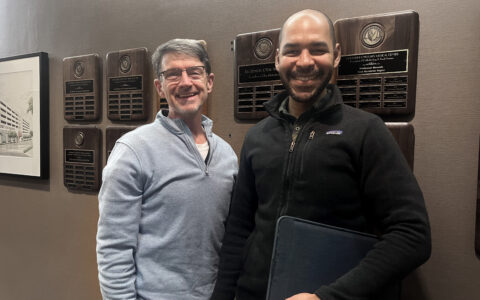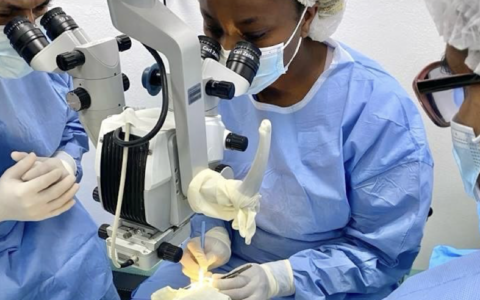Visual outcomes in glaucoma are being improved with early detection and routine testing. Yet, some types of these evaluations, especially testing of peripheral vision, can be uncomfortable, particularly for older patients, who are at higher risk for the condition. Moreover, the testing process often entails long waits in the clinic.
Ophthalmologist Sylvia Groth, M.D., at the Vanderbilt Eye Institute at Vanderbilt University Medical Center, is acutely aware of this shortfall in patient care and is working to address it.
“Almost to a person, when I tell patients we need to do a visual field test on their next visit, they say, ‘I hate that!’” Groth said. “We have been testing peripheral vision in the same way for many decades, and the machine is cumbersome, large, expensive, and boring.”
To make routine glaucoma testing more physically comfortable and even available for use in the home setting, Groth is turning to virtual reality (VR).
She and Alberto Gonzales-Garcia, M.D., founder of Olleyes, whom she met at an ophthalmology conference, have worked together on a new visual-field glaucoma testing system using his technology, with Groth providing clinical insight. The result is an immersive VR-based system, VisuALL, that Groth says performs visual-field testing in a more comfortable, versatile, and portable way.
“Telemedicine has been a boon to other subspecialties but has been limited within ophthalmology due to our dependence on device-based data gathering,” Groth said. “The more time we can free up in the clinical exam chair, the more benefit to our urgent and medically unstable patients.”
Portability = Happier Patients
The VR perimeter, or visual-field, test employs a wearable, goggle-like device with a Bluetooth-connected handpiece to control on-screen functions. It is lightweight, permits head movement and is portable, a feature Groth calls a game-changer.
The VR set can be sent to patients’ homes, much as Holter monitors are done for monitoring of disease progression. Groth says this could reduce the in-clinic wait times for testing on a standard visual-field machine.
“The more time we can free up in the clinical exam chair, the more benefit to our urgent and medically unstable patients.”
“I wanted to find something that works as well as the gold standard, with excellent reliability over repeated exams,” Groth said, in reference to the reliable Humphrey Field Analyzer and Octopus perimetry machines.
“I think it’s very viable for reducing both the numbers of visits and wait times, which are a dramatic drag on patient satisfaction.”
Testing Detection of Afferent Signals
In 2021, Groth published the results of a small pilot study in which she described the technical aspects of the VisuALL as tested on three healthy subjects. Testing time was about four and a half minutes per eye, approximating the time for Humphrey Field Analyzer or Octopus tests. There were no false negatives, and the small number of false positives approximated those of the standard tests.
The study concluded that the “the VR-based visual-field test shows potential to become an alternative to analog, stationary, standard automated perimetry tests.”
“I see this technology revolutionizing the way we approach long-term glaucoma management.”
Reproducibility Studies on Deck
The validity of the thresholding algorithms is still under investigation, Groth said.
“It is unclear if these programs will have adequate sensitivity to detect subtle field defects or accurately monitor disease progression,” she said.
Future tests, particularly those that measure reproducibility of results, will enable fine-tuning of the system, and Groth is laying the foundation for an adult study of test-retest variability and further validation of the device for clinicians.
She believes the VR sets may be most useful for patients whose glaucoma is relatively stable – which covers about 35 percent of her patients.
“I see this technology revolutionizing the way we approach long-term glaucoma management, and this is why I’m being so diligent in setting up rigorous validation,” Groth said. “I want to have high confidence in the technology when I fully incorporate it into my practice.”
Groth is also exploring VR applications for children with glaucoma. She has amassed a pediatric database documenting VR test data in normal children. Now, she is part of a small consortium of academic institutions recruiting children with visual-field defects, ultimately working toward validation of the VR method for pediatric use.




